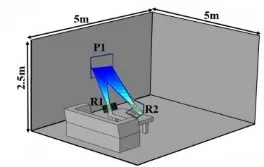Consumers would clearly appreciate a better means to charge mobile electronic devices. Current technologies, such as charging pads and cables, are inconvenient and restrict device mobility. This issue is being addresses by a research team lead by David Smith, professor and chair of the Department of Electrical and Computer Engineering within the Pratt School of Engineering at Duke University (Durham, NC). The team is developing a long range, line of sight wireless charging system.
First, a little background information.
One type of currently available wireless charging system uses a resonant magnetic near-field to transmit energy. Unfortunately, with this approach, the power transfer efficiency drops off rapidly with distance.
A second approach uses microwaves. With this technology, power can be transferred over a greater distance, much more than the size of a room. One problem with this approach is that, to transfer microwave energy efficiently, it must be directed and focused on the device that is to be charged. This is illustrated in the figure below and is analogous to a lens focusing and aiming a beam of light.
One means for an antenna to direct and focus microwaves is to use a steerable antenna dish. This is obviously not a practical solution for indoor and home use.
Another means to direct and focus microwaves is to use a phased array. In this case, the antenna is now composed of a large group of tiny antennas. The directing and focusing functions are accomplished by generating different amplitude or phase profiles for each antenna in the array. Unfortunately, this approach would cost too much and consume too much energy for household use.
The approach developed by the team is a variation on the phased array wireless power transfer approach. The high cost of other phased array approaches is reported as overcome through the use of so-called metasurface guided-wave apertures. The metasurface is made from metamaterials. These are synthetic materials composed of many individual, engineered cells that together produce properties not found in nature.
The latest results of the team appear in an article entitled “An Analysis of Beamed Wireless Power Transfer in the Fresnel Zone Using a Dynamic, Metasurface Aperture.” The article was published on October 23rd in the Journal of Applied Physics. A copy of the article is available for purchase here.
In this paper, the team provides a theoretically analysis that demonstrates that the technology already exists to build the envisioned metamaterials-based wireless power system.
The paper analyzes key parameters of the proposed wireless charging system such as spot and aperture size, wavelength, focal distance, the availability of sources, energy transfer efficiency and coverage volume. According to the results, a flat metamaterial-based transmitter no bigger than a typical flat-screen television could focus beams of microwave energy down to a spot about the size of a cell phone within a distance of up to ten meters. Such a system is reported as capable of powering more than one device at the same time.
There are, of course, challenges to engineering such a wireless power transfer system. It will be necessary to develop a powerful, low-cost, and highly efficient electromagnetic energy source. In addition, the software and controls for the phased array would have to be optimized to focus powerful beams while at the same time suppressing any unwanted secondary “ghost” beams.
There is also one other and rather obvious challenge that comes to mind. It is the ability to safely direct focused beams of microwave energy to devices that need to be charged while avoiding unwanted exposure to people, pets and other objects. To address this issue, the team envisions that each device would signal its presence in the room and communicate its location and orientation with respect to the transmitter. If the device is being powered, it would indicate to the transmitter that power is being delivered. If the direct path were to be blocked for any reason, the system would immediately shut down. This last bit seems really important to get right!
As a final note, Meko has recently reported on another wireless charging technology, that developed by Energous (San Jose, CA). Interested subscribers can find the article that contains comments on Energous here. -Arthur Berman
University of Washington, Matt Reynolds, 206-616-5046, [email protected]

